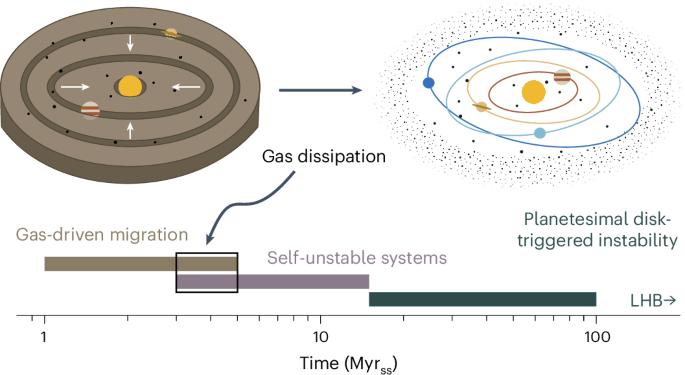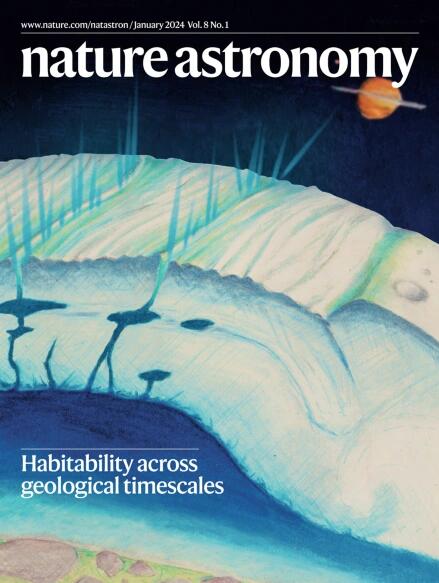An early giant planet instability recorded in asteroidal meteorites
IF 14.3
1区 物理与天体物理
Q1 ASTRONOMY & ASTROPHYSICS
引用次数: 0
Abstract
Giant planet migration appears widespread among planetary systems in our Galaxy. However, the timescales of this process, which reflect the underlying dynamical mechanisms, are not well constrained, even within the Solar System. As planetary migration scatters smaller bodies onto intersecting orbits, it would have resulted in an epoch of enhanced bombardment in the Solar System’s asteroid belt. Here, to accurately and precisely quantify the timescales of migration, we interrogate thermochronologic data from asteroidal meteorites, which record the thermal imprint of energetic collisions. We present a database of 40K–40Ar system ages from chondrite meteorites and evaluate it with an asteroid-scale thermal code coupled to a Markov chain Monte Carlo inversion. Simulations require bombardment to reproduce the observed age distribution and identify a bombardment event beginning $$11.{3}_{-6.6}^{+9.5}\, {\mathrm{Myr}}$$ after the Sun formed (50% credible interval). Our results associate a giant planet instability in our Solar System with the dissipation of the gaseous protoplanetary disk. Radiometric cooling ages of chondrite meteorites record asteroid belt bombardment beginning approximately 11 million years after the formation of the Solar System, indicating an episode of giant planet migration at that time.


小行星陨石中记录的早期巨行星不稳定性
在我们银河系的行星系统中,巨行星迁移似乎很普遍。然而,即使在太阳系内,这一过程的时间尺度也没有得到很好的制约,而这一尺度反映了基本的动力学机制。由于行星迁移会将较小的天体分散到相交的轨道上,这将导致太阳系小行星带出现一个轰击增强的时代。在这里,为了准确和精确地量化迁移的时间尺度,我们询问了小行星陨石的热年代学数据,这些数据记录了高能碰撞的热印记。我们提供了一个来自软玉陨石的 40K-40Ar 系统年龄数据库,并通过小行星尺度热代码和马尔科夫链蒙特卡罗反演对其进行了评估。模拟需要轰击来重现观测到的年龄分布,并确定了一个轰击事件开始于太阳形成之后(50%可信区间)(11.3}_{-6.6}^{+9.5}\, {\mathrm{Myr}}\ )。我们的结果将太阳系的巨行星不稳定性与气态原行星盘的消散联系起来。
本文章由计算机程序翻译,如有差异,请以英文原文为准。
求助全文
约1分钟内获得全文
求助全文
来源期刊

Nature Astronomy
Physics and Astronomy-Astronomy and Astrophysics
CiteScore
19.50
自引率
2.80%
发文量
252
期刊介绍:
Nature Astronomy, the oldest science, has played a significant role in the history of Nature. Throughout the years, pioneering discoveries such as the first quasar, exoplanet, and understanding of spiral nebulae have been reported in the journal. With the introduction of Nature Astronomy, the field now receives expanded coverage, welcoming research in astronomy, astrophysics, and planetary science. The primary objective is to encourage closer collaboration among researchers in these related areas.
Similar to other journals under the Nature brand, Nature Astronomy boasts a devoted team of professional editors, ensuring fairness and rigorous peer-review processes. The journal maintains high standards in copy-editing and production, ensuring timely publication and editorial independence.
In addition to original research, Nature Astronomy publishes a wide range of content, including Comments, Reviews, News and Views, Features, and Correspondence. This diverse collection covers various disciplines within astronomy and includes contributions from a diverse range of voices.
 求助内容:
求助内容: 应助结果提醒方式:
应助结果提醒方式:


